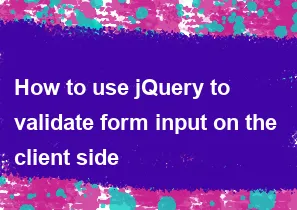How to use jQuery to validate form input on the client side

To use jQuery for client-side form validation, you can follow these general steps. jQuery makes it easy to select and manipulate HTML elements, making form validation more straightforward.
Include jQuery: Make sure to include the jQuery library in your HTML file. You can download it from the jQuery website or use a CDN.
html<!-- Include jQuery --> <script src="https://code.jquery.com/jquery-3.6.4.min.js"></script>Create your HTML form: Set up your HTML form with the necessary input fields, labels, and a submit button.
html<form id="myForm"> <label for="username">Username:</label> <input type="text" id="username" name="username" /> <label for="password">Password:</label> <input type="password" id="password" name="password" /> <input type="submit" value="Submit" /> </form>Write jQuery code for validation: Add a script section to your HTML file and write jQuery code for form validation. Use the jQuery
submitevent to capture the form submission and validate the form fields.html<script> $(document).ready(function() { $("#myForm").submit(function(event) { // Prevent the form from submitting event.preventDefault(); // Validate the form fields if (validateForm()) { // If validation passes, you can submit the form or perform other actions alert("Form submitted successfully!"); } }); function validateForm() { // Perform validation for each form field var username = $("#username").val(); var password = $("#password").val(); // Example validation: Check if the username and password are not empty if (username.trim() === "" || password.trim() === "") { alert("Username and password are required!"); return false; // Validation failed } // Additional validation logic can be added here // If all validation passes, return true return true; } }); </script>In the example above, the
validateFormfunction checks if the username and password are not empty. You can customize the validation logic based on your requirements.Enhance validation logic: Depending on your form requirements, you may need more complex validation, such as checking email formats, password strength, or validating using regular expressions.
javascript// Example: Validate email format var email = $("#email").val(); var emailRegex = /^[^\s@]+@[^\s@]+\.[^\s@]+$/; if (!emailRegex.test(email)) { alert("Invalid email format!"); return false; // Validation failed }
Remember to adjust the validation logic according to your specific requirements and form fields. This is a basic example, and you may need to add more sophisticated validation based on your use case.
-
Popular Post
- How to optimize for Google's About This Result feature for local businesses
- How to implement multi-language support in an Express.js application
- How to handle and optimize for changes in mobile search behavior
- How to handle CORS in a Node.js application
- How to use Vue.js with a UI framework (e.g., Vuetify, Element UI)
- How to configure Laravel Telescope for monitoring and profiling API requests
- How to create a command-line tool using the Commander.js library in Node.js
- How to implement code splitting in a React.js application
- How to use the AWS SDK for Node.js to interact with various AWS services
- How to use the Node.js Stream API for efficient data processing
- How to implement a cookie parser middleware in Node.js
- How to implement WebSockets for real-time communication in React
-
Latest Post
- How to implement a dynamic form with dynamic field styling based on user input in Next.js
- How to create a custom hook for handling user interactions with the browser's device motion in Next.js
- How to create a custom hook for handling user interactions with the browser's battery status in Next.js
- How to implement a dynamic form with dynamic field visibility based on user input in Next.js
- How to implement a dynamic form with real-time collaboration features in Next.js
- How to create a custom hook for handling user interactions with the browser's media devices in Next.js
- How to use the useSWRInfinite hook for paginating data with a custom loading indicator in Next.js
- How to create a custom hook for handling user interactions with the browser's network status in Next.js
- How to create a custom hook for handling user interactions with the browser's location in Next.js
- How to implement a dynamic form with multi-language support in Next.js
- How to create a custom hook for handling user interactions with the browser's ambient light sensor in Next.js
- How to use the useHover hook for creating interactive image zoom effects in Next.js